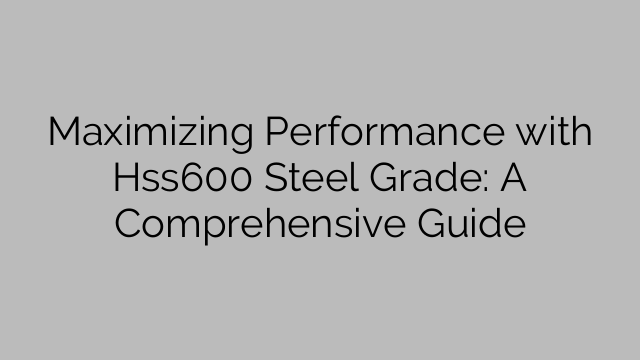Maximizing Performance with Hss600 Steel Grade: A Comprehensive Guide
In the manufacturing and engineering industries, the choice of steel grade plays a crucial role in determining the performance and longevity of the end product. Hss600 steel grade, known for its high strength, toughness, and wear resistance, has gained popularity among manufacturers for its exceptional performance in demanding applications.
Here’s a comprehensive guide on how to maximize performance with Hss600 steel grade:
Understanding Hss600 Steel Grade
Hss600 is a high-strength structural steel grade that offers exceptional mechanical properties, making it suitable for use in a wide range of applications. It is characterized by its high yield strength, excellent toughness, and superior wear resistance, making it an ideal choice for components subjected to high impact and abrasive forces.
Maximizing Performance
To ensure optimal performance when working with Hss600 steel grade, it is essential to take into consideration the following aspects:
1. Material Selection: The first step in maximizing the performance of Hss600 steel grade is to select the right material for the specific application. Consider the environmental conditions, load requirements, and the level of wear and tear the component will be subjected to. Additionally, consider the fabrication and machining processes involved in working with Hss600 steel grade to ensure compatibility and ease of manufacturing.
2. Heat Treatment: Heat treatment plays a crucial role in enhancing the mechanical properties of Hss600 steel grade. Annealing, quenching, and tempering are common heat treatment processes used to improve the hardness, strength, and toughness of the material, ultimately enhancing its performance in demanding applications.
3. Machining and Fabrication: When it comes to machining and fabricating components from Hss600 steel grade, it is important to use appropriate cutting tools and machining techniques to achieve the desired precision and surface finish. Carbide or ceramic cutting tools are recommended for machining Hss600 steel grade due to its high hardness and wear resistance.
4. Surface Treatment: To further enhance the performance and longevity of components made from Hss600 steel grade, consider applying surface treatments such as nitriding, carburizing, or coating. These treatments can improve the wear resistance, corrosion resistance, and surface hardness of the material, making it more durable and suitable for harsh operating conditions.
5. Testing and Quality Control: Finally, it is crucial to conduct thorough testing and quality control measures to ensure the performance and reliability of components made from Hss600 steel grade. Non-destructive testing methods such as ultrasonic testing, magnetic particle inspection, and dye penetrant testing can be used to identify any defects or inconsistencies in the material.
In conclusion, maximizing performance with Hss600 steel grade requires careful consideration of material selection, heat treatment, machining and fabrication techniques, surface treatments, and quality control measures. By following this comprehensive guide, manufacturers can ensure the superior performance and longevity of components made from Hss600 steel grade, making it an ideal choice for demanding applications in various industries.

